Why they failBearing life is dependent on loading:
* A over tensioned belt can reduce the radial loading on the rear (fit a FS tensioner)
* Crushed spacers, as a result of over-torqueing the axles, will result in overloading the bearings axially even when at the correct torque post damage
Who makes bearings* The stock ones are NTN, a reputable supplier.
* SKF and FAG are reputable suppliers too, are a fraction of the price and easier to get hold of in the UK.
Which bearings do I need?For XB and 1125, SKF part numbers are:
* Front
6005-2RSH* Rear
6006-2RS1For XB and 1125, FAG part numbers are (can't get links to work for these prodcts on their website):
* Front 6005-2RSR
* Rear 6006-2RSR
For XB and 1125, Buell part numbers are:
* Front
E0004.02A8A* Rear
E0005.02A8ASteer clear of C3, they have increased clearance (read part-worn from new) for high temperature operation...
Should I replace my spacers at the same time?For XB and 1125, spacer numbers are:
* Front
G0325.02A8* Rear
G0323.02A8How can I get my bearings out?A blind bearing puller is the weapon of choice. Make sure it has the correct sized collets. For the front you need a collet suitable for a 25mm bore, for the rear, you need one suitable for a 30mm bore.
The wheel can be suspended over a suitable tyre by the puller shaft, then left to drop whilst maintaining grip on the slide hammer. This applies a steady load and a shock.
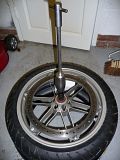

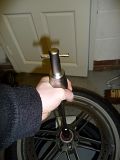
An alternative to the blind bearing puller is an expanding rawl bolt of adequate size. After inserting and expanding (careful not to wreck the spacer), a punch can be used from the opposite side to knock the bearing through.
There has been some success (difficult but do-able) using a punch from the opposite side. The angle is tight and there is only about 1mm of the bearing inner race to knock.
A warm wheel will help, you could leave it in the house overnight and/or warm the hub with a hot air gun (careful with the paint).
How can I get my bearings in?The first tip is to get the bearing as cold as possible to *shrink* it. This can be done by putting the bearings in a freezer bag and leaving them in the freezer overnight.
In addition, the wheel should ideally be warm, see above.
Use some copaslip around the bearing area. This will make the insertion a tad easier, but also help to prevent the bearing and hub from becoming attached over the life of the bearing. If this happens, they are a pain to get out...
To drive the bearings in, you need to ensure they go in concentric and that you dont shag up the bore in the hub.
A number of methods exist:
* Tapping the bearings in by hand (carefully - tapping the outer race only)
* Threaded rod with large sockets on the outer race
* Threaded press with collets (metal or hard wood)
* Hydraulic press and socket
I use my fantastic do-it-all threaded brass stud with aluminium collets shown here for:
* 1" bicycle headset
* XB front wheel bearings
* XB rear wheel bearings
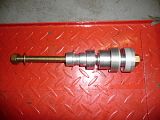
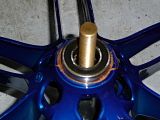
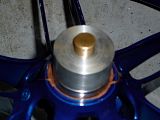
Buell tools
here.
The procedure is as follows:
1. Insert first bearing. On a single disc wheel, this will be on the disc side, on a twin disc wheel, on the left side.
2. Insert spacer
3. Insert second bearing (non-disc or right side)
If you attempt to press both bearings in at once, the spacer tube is likely to be damaged by the hub.
TubersThe spacer on a tuber has a lot more radial movement allowing you to use a drift through the centre of the bearing. When the bearings are worn out, the spacer is easy to move. When the bearings are new, the spacer is an interference fit between the two bearings.
Tuber wheel bearings (cast wheels)
Front 6204 (x2 bearings)
Rear 6205 (x2 bearings) + 62205 (x1 bearing, it's a bit wider than the other two)
Tuber wheel bearings (PM wheels)
Front 6204 (x2 bearings)
Rear 6205 (x3 bearings)
All are 2RS (In SKF - 2RSH is preferable but 2RS1 if H is not available)








